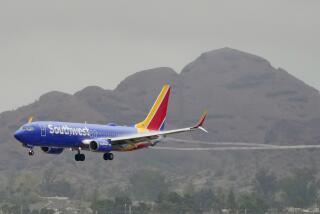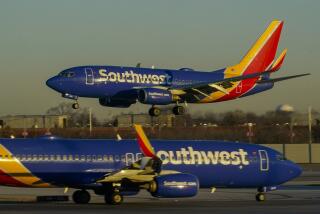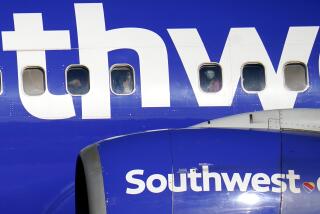Low-cost airlines prompt majors to play their game
Low-fare airlines and the majors are flying so close together that someone should file a near-miss report. The line between no-frills and full service is quickly blurring. Consider these recent changes:
* Starting in the fall, JetBlue passengers will get more legroom. The upstart discounter, which already provides leather upholstery and a TV screen at every seat, will offer 34 inches of âseat pitchâ (distance between seat backs) instead of 32. Some American Airlinesâ coach customers, meanwhile, soon will lose up to 3 inches of room they gained three years ago. American said it would put back seats on some planes to enable it to offer âcompetitive fares.â
* As for Southwest, itâs true thereâs been no free lunch -- or any other hot meal -- for years on this âflying busâ pioneer. But now US Airways has stopped serving free meals in coach on most longer domestic flights. Passengers may buy food on board or bring their own. Several other majors are trying similar programs.
* Remember when we derided discounters as cattle cars? You donât have to fly one to feel claustrophobic today, as cash-strapped majors cut flights to match demand drained by terrorist attacks, the recession, Iraq War jitters and the outbreak of severe acute respiratory syndrome, or SARS.
Continental and United, for instance, flew fuller than ever last month. More than 80% of their seats were occupied on average, compared with fewer than 75% of Southwestâs. Thatâs good news for the majors, all of which posted higher so-called load factors in June, but not so pleasant for passengers on filled or overbooked flights.
These changes result from a seismic shift in the airline industry, as the financially struggling majors duke it out with discounters for a dwindling pool of travelers. Itâs a âmajor correctionâ similar to what periodically shakes up the stock market, said Terry Trippler, air traveler advocate for www.cheapseats.com.
Delta Air Lines Chief Executive Leo Mullin, in a speech last month in Washington, D.C., predicted a âslugfestâ between traditional hub-and-spoke airlines like his and the low-fare point-to-point carriers.
What makes the battle at once bruising for airlines and perfect for penny-pinching passengers is that the Internet makes it so easy to compare fares.
âThe Internet has put pricing power in the hands of customers,â said Phil Roberts, vice president and managing partner of Unisys R2A, an airline consulting company in Hayward, Calif. âThereâs no place to hide.â
Airlines, as a result, are forced to drop fares to the lowest common denominator. To survive, the majors, saddled with costs too high to afford these fares, are reducing flights and on-board service. The lean-operating low-fare airlines, flush with cash and hope, are âordering planes as fast as they can build them,â Trippler said -- and adding a service perk or two. The result: The two sides of the industry are starting to meld.
âItâs almost at the point that when you say âthe majors,â you have to include Southwest, JetBlue and ATA,â Trippler said. Southwest, for instance, says itâs the nationâs fourth-largest carrier, based on boardings last year.
Roberts goes a step beyond. He shuns the word âmajorâ and, like many experts, has taken to calling American, Delta, Northwest and their ilk âlegacy carriers,â which refers to their existence before the industry was deregulated in 1978.
He also dislikes the terms âlow-fareâ and âdiscountâ carriers. Air Tran, for instance, has a business class. And itâs most often the legacy carriers who do the discounting, in his view, to match the low fares of the âdiscounters.â Roberts prefers to call Southwest and similar airlines âlow-cost carriers,â based on how they run the business. (To further complicate the distinction, Southwest and ATA existed before deregulation, albeit not in their current forms.)
Whatever they are called, this diverse collection of low-cost carriers is gaining quickly on the legacy airlines. While the legacy lines reduce flights and delay plane deliveries, Southwest has added about 35 flights since January, and JetBlue boarded 60% more passengers in June than it did the previous June.
Numbers plucked from U.S. Department of Transportation reports by Hyuk Park, senior Unisys R2A analyst, show the inroads being made:
Legacy airlines -- including Alaska, American, Continental, Delta, Northwest, United and US Airways -- lost more than 15 million passengers overall in two years, as measured by boardings in the continental U.S. (except Alaska) in the first quarter compared with the first quarter of 2001. The main low-cost carriers -- including America West, Air Tran, ATA, Frontier, JetBlue, Southwest and Spirit -- collectively held their own.
Legacy carriers handled about 63% of the nationâs passengers in the first quarter, and the low-cost carriers about 26%, with regional carriers boarding the balance.
The low-cost airlinesâ ascent is even more dramatic in California, where Southwest has long been strong and JetBlue has blossomed from its Long Beach base. Such carriers boarded 42% of customers at the stateâs top 10 airports in the first quarter, up from 35% in 2001, Park said.
Passengers stand to gain from this development despite the temporary pain of lost pampering.
âEventually the whole industry will operate on a low-cost basis,â Roberts said, making it possible to blend bargain fares with reasonable levels of service
Until then, in their quest for a winning financial formula, the legacy airlines will test our tolerance: Will we pay for meals? Put up with crowding or less convenient schedules? And the new entrants will add routes and maybe perks.
In the end, as passengers, we are, perhaps, more powerful than we think.
Jane Engle welcomes comments and suggestions but cannot respond individually to letters and calls. Write Travel Insider, Los Angeles Times, 202 W. 1st St., Los Angeles, CA 90012, or e-mail [email protected].
More to Read
Sign up for The Wild
Weâll help you find the best places to hike, bike and run, as well as the perfect silent spots for meditation and yoga.
You may occasionally receive promotional content from the Los Angeles Times.






